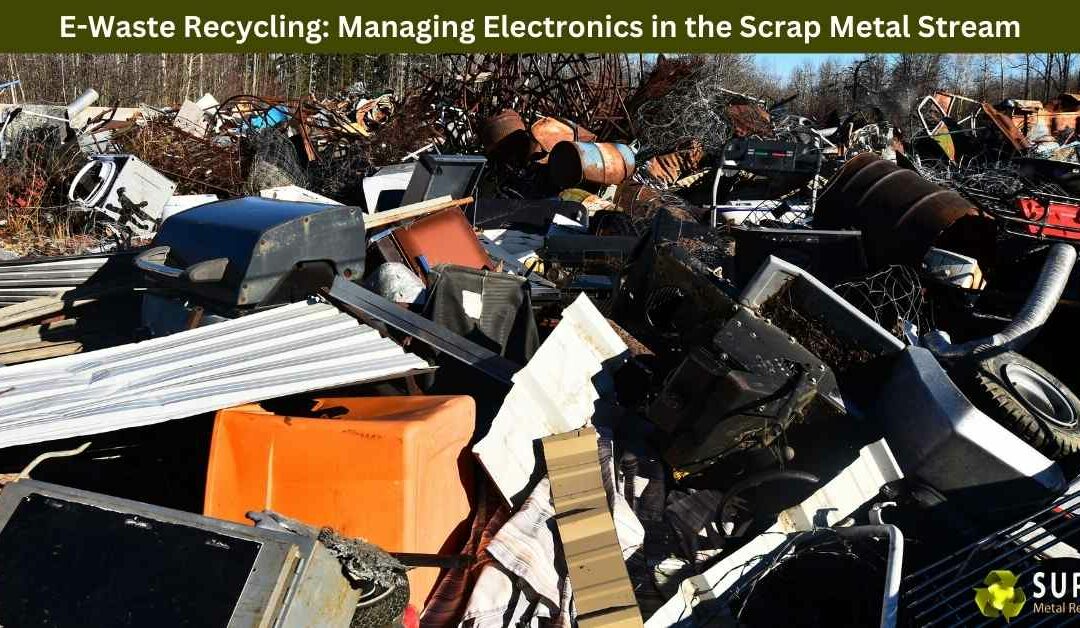In today’s digital age, electronic devices have become an integral part of daily life, driving innovation, connectivity, and productivity. However, the rapid pace of technological advancement also leads to the accumulation of electronic waste, or e-waste, which poses significant environmental and health hazards if not managed properly. E-waste contains valuable metals and materials that can be recovered through recycling, making it essential to integrate e-waste management into the broader scrap metal recycling stream. In this article, we explore the challenges and opportunities of e-waste recycling, focusing on effective strategies for managing electronics within the scrap metal stream.
The Significance of E-Waste Recycling
E-waste encompasses a wide range of electronic devices, including smartphones, computers, televisions, and appliances, that are discarded at the end of their lifecycle. These devices contain valuable metals such as gold, silver, copper, and palladium, as well as hazardous materials like lead, mercury, and brominated flame retardants. The improper disposal of e-waste can result in pollution of air, water, and soil, posing risks to human health and the environment.
E-waste recycling offers a sustainable solution to mitigate these risks while recovering valuable resources for reuse. By recycling e-waste, we can:
- Preserve Natural Resources: Recycling e-waste reduces the need for virgin materials extraction, conserving natural resources and minimizing environmental degradation associated with mining and processing.
- Prevent Pollution: Proper e-waste recycling prevents the release of hazardous substances into the environment, protecting air and water quality and reducing the risk of contamination in surrounding ecosystems.
- Promote Circular Economy: E-waste recycling promotes the principles of a circular economy by recovering valuable materials from discarded electronics and reintroducing them into the production cycle. This reduces reliance on finite resources and fosters sustainable consumption and production practices.
Challenges of Managing Electronics in the Scrap Metal Stream
Integrating e-waste recycling into the broader scrap metal stream presents several challenges, including:
- Collection and Sorting: E-waste collection and sorting require specialized infrastructure and processes due to the diverse range of electronic devices and materials involved. Effective collection methods and sorting technologies are needed to separate e-waste from other scrap metal streams and facilitate efficient recycling.
- Hazardous Materials Management: E-waste contains hazardous substances, such as lead, mercury, and brominated flame retardants, which pose health and environmental risks if not managed properly. Recycling facilities must adhere to strict safety protocols to handle and dispose of hazardous materials safely.
- Data Security and Privacy Concerns: Electronic devices often store sensitive personal or corporate data, raising concerns about data security and privacy during the recycling process. Proper data sanitization and destruction procedures are essential to protect confidential information and prevent unauthorized access.
- Technological Obsolescence: The rapid pace of technological advancement leads to frequent upgrades and replacements of electronic devices, resulting in a steady influx of obsolete e-waste. Recycling facilities must stay abreast of emerging technologies and market trends to effectively manage and process obsolete electronics.
Strategies for Effective E-Waste Recycling in the Scrap Metal Stream
To address the challenges of managing electronics in the scrap metal stream, several strategies can be implemented:
- Dedicated E-Waste Recycling Facilities: Establish specialized e-waste recycling facilities equipped with advanced sorting, processing, and disposal capabilities to handle electronic devices safely and efficiently.
- Public Awareness and Education: Raise awareness among consumers and businesses about the importance of e-waste recycling and the proper disposal of electronic devices. Educate stakeholders about the environmental and social impacts of e-waste and promote responsible recycling behaviors.
- Extended Producer Responsibility (EPR) Programs: Implement EPR programs that hold manufacturers accountable for the end-of-life management of their products, including e-waste recycling and disposal. Require manufacturers to take responsibility for collecting, recycling, and properly disposing of electronic devices at the end of their lifecycle.
- Collaboration and Partnerships: Foster collaboration between government agencies, recycling facilities, manufacturers, and stakeholders across the supply chain to develop coordinated e-waste recycling initiatives. Pool resources, expertise, and infrastructure to enhance the efficiency and effectiveness of e-waste recycling efforts.
E-waste recycling is essential for managing electronics within the scrap metal stream and promoting sustainable resource management practices. By recovering valuable metals and materials from discarded electronics, we can reduce environmental pollution, conserve natural resources, and foster a circular economy. Effective e-waste recycling requires collaboration, innovation, and public engagement to overcome challenges and maximize the environmental and economic benefits of recycling electronic devices. Together, we can build a more sustainable future by responsibly managing e-waste and integrating electronics recycling into the broader scrap metal recycling stream.
If you are in Knoxfield, Victoria 3180, and looking for a metal recycling service, this is the best way to visit us.
Super Metal Recycling
345 Frankston – Dandenong Road, Dandenong South VIC 3175
(03) 9706 4909


Recent Comments